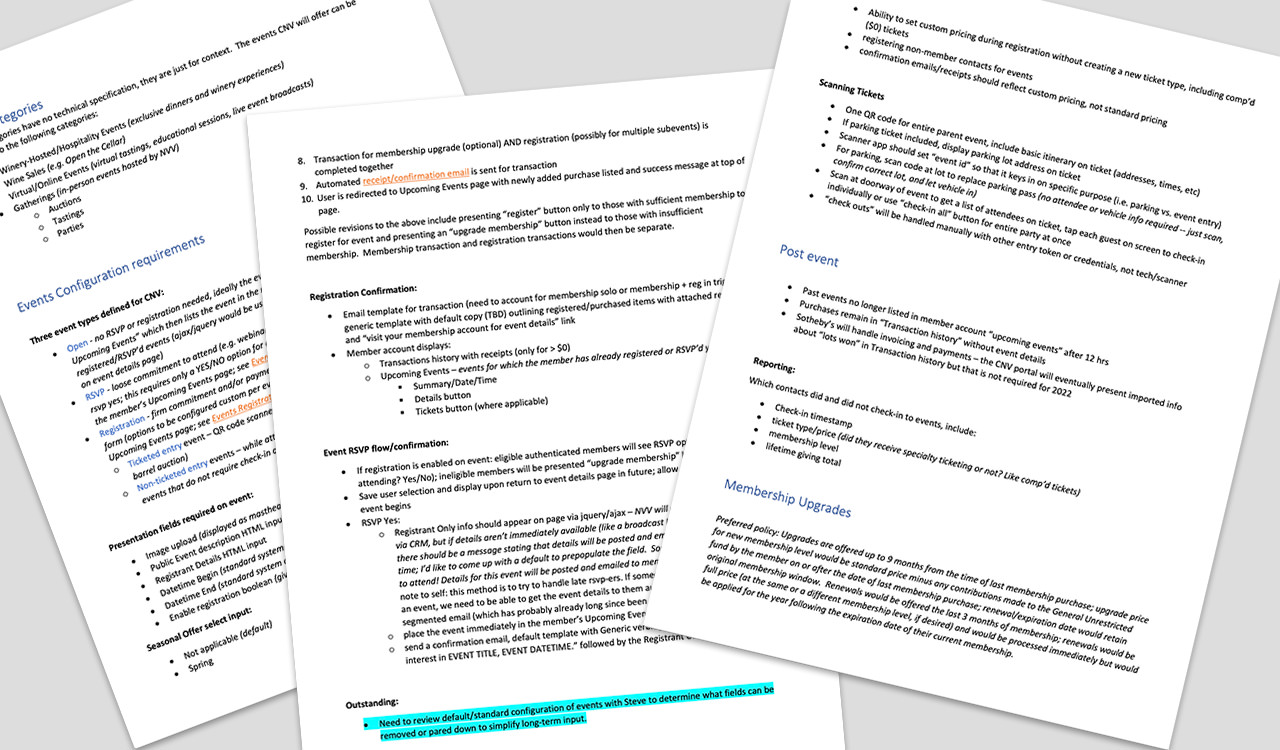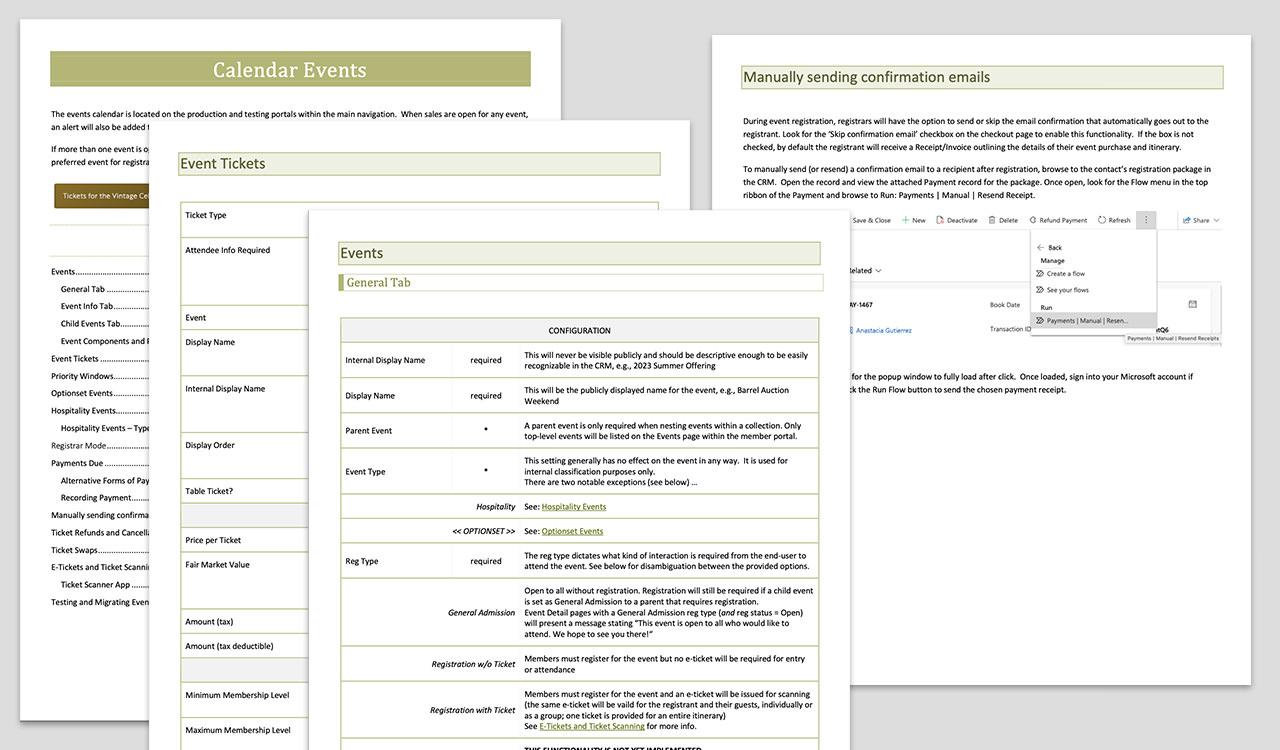Implement a new CRM model and event ticketing system for a Napa Valley community fundraising auction held annually and attended internationally for over 40 years.
-
Timeline
2021–2022
-
Team
2–13
-
Role
Product Manager | Technical Consultant | UX Engineer

The Background
Following a hiatus necessitated by the COVID-19 restrictions on large gatherings and events, Auction Napa Valley (ANV)—the charity wine auction hosted annually by the Napa Valley Vintners for over 40 years—was re-imagined to become a membership-based philanthropic collective, offering exclusive access to year-round events and benefits throughout Napa Valley. Positioned to engage more wine enthusiasts and ready to begin fundraising again for local community non-profits, Collective Napa Valley would need a new model for customer relations, event sales, and ticketing.
The Motivation
The technology that had shaped and supported the ANV event could not meet the new model’s requirements and priorities, so the Napa Valley Vintners needed to move quickly to implement a new technology stack in order to meet ambitious deadlines for the next event in 2022.
My Role
Tasked with researching and implementing a Customer Relationship Management (CRM) system and a flexible events ticketing system in less in six months time, Napa Valley Vintners (NVV) staff immediately enlisted my help as a long-time collaborator to keep the project moving quickly and efficiently through the entire lifecycle of the project.
The Process
Defining Requirements and Objectives
Working closely with the NVV in-house lead, my first objective was to define a list of requirements I could use to evaluate CRM products on the market. I then began research online to identify the top contending products available, based on their usability, feature sets, and cost of operation.
Considerations
- Intuitive interfaces would ease onboarding and adoption for non-technical staff
- Widely supported CRM systems would ease the burden of support and development for future projects
- The CRM would also need to be paired with an events registration and ticketing system with a full-featured portal that could be customized to match Collective Napa Valley’s branding
Research
The research phase began with simply educating myself about Customer Relationship Management systems so that I could knowledgeably evaluate their value and potential for Collective Napa Valley.
Searching online to identify a list of viable CRM products, I began to collect and collate common features that would be of use to Napa Valley Vintners staff. From that list, subsequent discussions with NVV staff, and a foundational understanding of the company’s culture and event requirements, I was able to define an ideal feature set by which I could evaluate each product individually.

Product Evaluations
Once I had gathered the data on features and products, I met with the NVV staff lead on the project to review my worksheets and winnow down the list of candidate CRMs in order to schedule interactive demos with their respective sales teams.
We chose to focus on four competing products based on those that could best meet project needs and began requesting demos immediately.
One of our top candidates was eliminated when they informed us that that did not work outside of the Arts sector. The three remaining candidates went through multiple rounds of demonstration and Q&A with their product teams.
What we found was that robust functionality often came at the cost of an intuitive user-interface, while those systems that embraced a more modern approach to software design patterns were limited by small development teams struggling to implement full functionality.
While no perfect product had presented itself, we were too pressed for time to commit to products that couldn’t be built upon and customized expediently.
Ultimately, we chose the platform that seemed to offer the best compromise for our immediate and long-term goals:
- A navigable interface that could be learned through special training sessions with consulting experts
- Feature-rich functionality built specifically for non-profit needs surrounding fundraising, events, and CRM
- Microsoft Dynamics Partner developers to shepherd our development and customization efforts to launch
- A budget-friendly pricing system that leveraged our existing Microsoft services and subscriptions
- A scalable and competent team of consultants willing to meet our aggressive deadlines
Partners
Eager to start development, Napa Valley Vintners hired Microsoft-accredited development partners, Boyer & Associates, to install and implement their Microsoft Dynamics Fundraising and Engagement services with an accompanying member portal.
We also introduced additional NVV staff to the team now that the product plan was in development. In total, there were three members representing NVV’s technical team and two NVV staff members in charge of the Collective Napa Valley program.
On the Boyer team, we worked with a principal architect, project manager, business analyst, and account manager.
All came together collaboratively to define the product customizations and data migration plan.
Planning
As a team, we outlined three stages of development and release:
The first phase would launch in three months and would focus on building the CRM administration panel and migrating data from NVV’s existing database to the Fundraising and Engagement app, as well as releasing a supporting website to gather interest for Phase 2.
The second phase would launch a month later with the ability to process memberships through the website portal.
The third phase would launch three months subsequent to announce event information and sell tickets for an upcoming event in June 2022.
Design and Development
Phase One
I would be in charge of all web and interface design, working with the Boyer team to build out the new member website and portal.
As the Microsoft Dynamics and Power Pages platforms were new environments for me, I spent time reviewing the capabilities and limitations of the portal templating system. I then began designing high-fidelity mockups for the website interface based on brand work done by a consulting designer, as well as previous work I’d done on brands for other Napa Valley Vintners’ properties.
The Collective Napa Valley Program Director provided me with content outlines for the site, which I then developed visually and returned as an inventory of copy requirements for the site before launch.
Although we’d hired consultants explicitly to help us build the technical infrastructure of the website, it became obvious a few weeks into the project that the product was new enough that the consulting team wasn’t able to offer much expertise on programming for the front-end. Development then became a process of learning through trial and error for me, working to adapt my existing knowledge of HTML, SASS, CSS, Javascript, and server-side languages to the new environment.
Since the product was largely targeted towards organizations with fewer expectations of customization, I found the provided infrastructure outdated and limiting. However, I was able to overlay upgrades to the underlying Bootstrap libraries to improve programmability. And from that foundation, I was able to build the key components and style library for the website.
Phase Two
Phase Two pushed farther into building the technical infrastructure of the project, requiring a deeper understanding of the platform’s ecosystem.
As I continued to work closely with Boyer staff, my understanding of and familiarity with the platform grew, both front- and back-end. Learning quickly, I began to take on updates requested by NVV Staff to facilitate data integrity and accessibility.
I also developed an excellent working rapport with our consulting developers, which allowed us both to consult and advise each other on the project specifications and requirements.
I began work throughout the platform to build processes and data architecture that met the needs of the project. I also began writing up feature requests based on internal meetings with NVV team members, translating their requirements into technical specifications for the Boyer team.

Phase Three
By the time we entered Phase Three of development, it was clear that we needed to shift our team structure to allow for streamlined project management of the remaining functionality. I took the lead on the NVV team, working as liaison between the non-technical and technical teams to scope out the remaining project.
I had also, by this time, become a knowledgeable member of the development team, offering insight into the project architecture, data infrastructure, and programming capabilities for the entire system. That experience allowed me to craft a detailed specifications document for our final phases in building out the event registration and ticketing systems.
From there, I served as a technical advisor and developer for the events and ticketing systems: programming new functionality, designing all the front-end interfaces and UX flows for the system, and competently explaining the complex requirements of NVV events and their technological consequences.
Testing and Quality Assurance
As the person most familiar with the product specifications and requirements, I led our shared efforts to ensure a consistent, quality product ready for launch.
We would collectively test in online sessions with the development and program teams. I also would define all the test cases and scenarios to properly ascertain that functionality was solid, reviewing various user-flows and patterns to establish testing procedures.

Product Launch
A core member of the development and product team, I worked extensively with Boyer and Associates consultants to outline our launch plan, including resources to be moved and tested, as well as debugging unexpected errors in the production environment.
With a difficult launch that took a very long weekend of troubleshooting to meet our final deadline, we successfully released tickets for sale to the Napa Valley Barrel Auction Weekend in April of 2022.
Event Support and Training
The team focus turned to sales and support for the upcoming event. In my capacity as technical lead and product manager, I began working with NVV Staff to train them on the tools and procedures for managing events in the CRM.
We also continued development on a ticket scanning app to be used on the day of the event for registrant check-ins and parking, working with Boyer and Associates to wireframe and then prototype the end product.

Documentation
After all development work was completed, I began documenting core functionality and infrastructure for the NVV and Boyer teams. This work formed as a reference for development and training, moving forward with new project leads stepping in to manage the product long-term.

Outcomes
On an exceedingly ambitious timeline, we were able to launch a robust and scalable event management and ticketing system, capable of handling Collective Napa Valley’s primary seasonal events. With the first year’s development work completed, I was able to return to the website to refactor the logic and code for greater flexibility/extensibility, allowing me to hand off all event configuration and support to NVV staff in 2023.